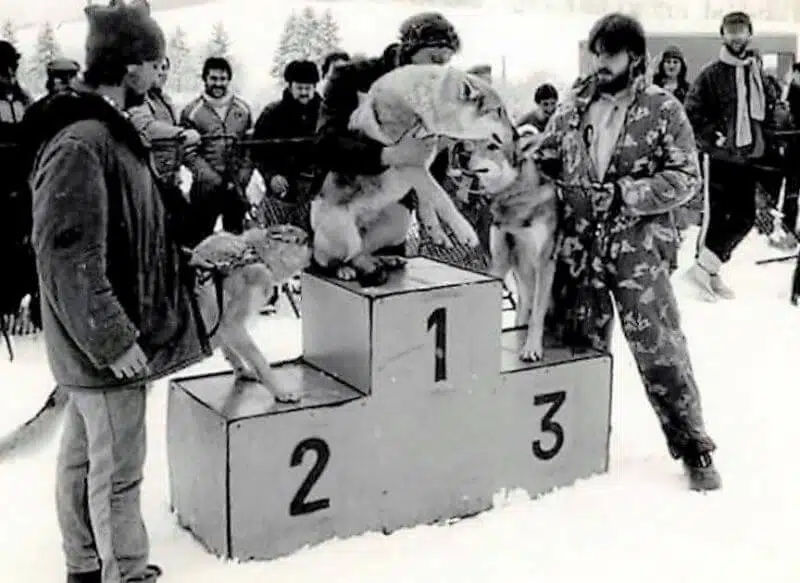Czechoslovakian Vlcak history
- Sharon DiGennaro
- Oct 18, 2022
- 3 min read
Updated: Dec 3, 2024
In 1958, a biological experiment took place in Czechoslovakia (CSSR at that time), which included forty working German Shepherds with four Carpathian wolves: Brita(♀), Argo(♂), Sarik(♂) and Lejdy(♀). Col. Karel Hartl, (“Hartl”), and Frantisek Rosik, (“Rosik”), were the co-founders of the breed. Hartl came up with the idea of using wolf DNA to develop a superior German Shepherd that has the hearing, scenting, sight, weather resistance and endurance of the wolf. Rosik, who was known by dog enthusiasts as “Dedo” (Granddad), had the idea of developing a new breed to become internationally recognized.

In 1964-65, the results of the experiment were published, and a new breed emerged that would be a quick learner, with a solid structure, high persistence, resistance to adverse conditions, and fast reactions. According to Hartl, the German Shepherds of the Border Guard had around 1200 dogs who had to be excluded from service at the age of eight due to their inability to continue to perform. Only 1% could tolerate the strains of service to the age of ten. The dogs showed low endurance and considerable fatigue when requested to cover distances of 31 miles at temperatures of 60 degrees Fahrenheit. Those same dogs took approximately sixty hours to recuperate after working in these conditions. The Border Guard dogs suffered frequent illnesses and a high puppy death rate. Hartl stated that the third generation of hybrids would overtake the German Shepherds on a track because of their superb orientation abilities, endurance in running, and the excellent, resilient quality of their fur.

The selective breeding process was the beginning of the dog we know today as the Czechoslovakian Vlčák (“CsV”). Being a more recently developed breed, the bloodlines are very well documented. Five distinct bloodlines resulted and were used in the breeding program. The breed lines were closed after the establishment of Lejdy’s bloodline.

On March 20, 1982 the Czechoslovakian Vlcak was recognized as the national breed of Czechoslovakia. The first 43 puppies were registered in Prague with the Main Pedigree Register. More than 1500 puppies would be registered over the next 10 years.
One of the requirements for recognition by Fédération Cynologique Internationale (FCI) – the world canine organization, was to show the breed’s working abilities. Rosik reached out to Peter Krotkovský, (“Krotkovskÿ”), who has been interested in Cynology since he was eight years old. Initially he had German Shepherds, but after meeting with ‘Granddad’ Rosík, he turned to breeding CsV. Krotkovský was tasked with building mushing teams and carts.
On January 16-17, 1988, the CsV mushing teams competed at their first sled race in Slovakia. The CsV teams were up against strong competition of the Nordic breeds and the Czech mountain dogs. The race was 12km (approximately 7.5 miles). The CsV teams won both categories. Krotkovský, Mirko Polák, and Juraj Bognár competed in Category C, which included 2-3 sled dogs and placed First, Second and Third respectively. Daniel Filo and Jindra Jedlička competed in Category B, which included 4-6 sled dogs and they placed First and Second respectively.
Encouraged by growing interest in the CsV, club members began to organize competitions where it was possible to exhibit the breed’s physical and behavioral traits as well as overall performance. Evaluation of the sled races determined that the CsV was not a sprinter but preferred mid to long-distance races using an energy-saving low trot. CsV reached an average speed of 12-13 km per hour (7.5-8mph). Based on this, the club set endurance testing conditions for the breed, which included running alongside the bike, for 40, 70 and 100km (SVP1, SVP2, SVP3). These are recognized as working exams in Slovakia. For the first time in history, 40km (Approximately 24.8 miles) speed races and 100km (approximately 62 miles) endurance runs with the dogs took place.
In 1989 the breed was granted provisional recognition by Fédération Cynologique Internationale, (“FCI”). The goals of the breed club were to continue breed development to achieve FCI breed recognition for its beauty, grace, grandeur, and great working abilities. Karel Hartl, František Rosík, Jozef Sopuch and Oskar Dóra collaborated on the breed standard based on the dog Rep z Pohranicni Straze (F3). Rep was born on November 11, 1979, and produced over 244 offspring. Rep contains blood from both Carpathian wolves, Sarik and Brita. The author of the illustrated CsV breed standard is Luboš Zaremba.
Today the breed is fully recognized by the FCI (1999), United Kennel Club (2006) and accepted into American Kennel Club’s Foundation Stock Service (2001). The CsV is an excellent guardian and companion. One of their tests (bonitation) shows they can cover 62 miles in less than 8 hours without any issues. Their olfactory characteristics are outstanding, and they possess superior eyesight, and hearing. The CsV is a versatile breed, built for endurance. They also excel in scent work, tracking/trailing and searching. They are extremely loyal, but exercise vigilance, especially with strangers.



